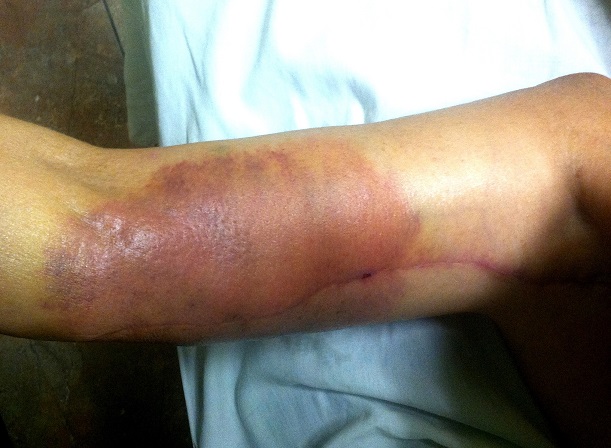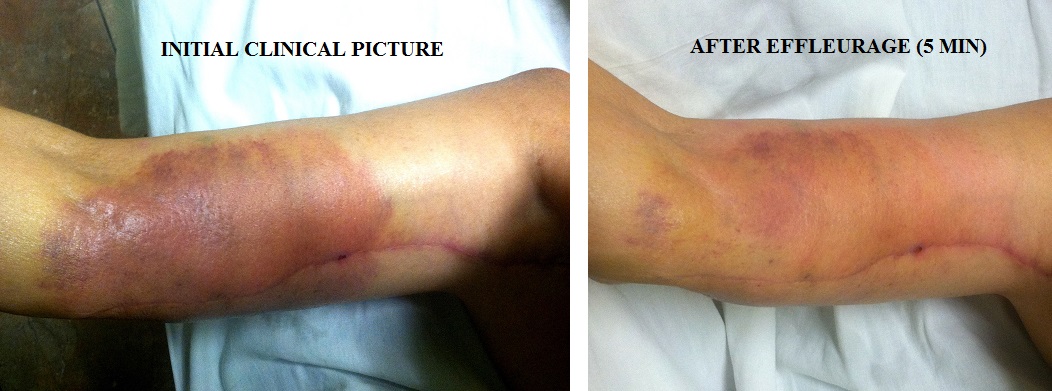By Dr. Ross Turchaninov, Phoenix, AZ
Effleurage is a very basic technique therapists use daily. However, even this basic massage technique delivers a profound impact on the body of the client/patient. At the same time, if this simple technique isn’t performed correctly its therapeutic impact greatly diminishes.
The therapist may observe or palpate outcomes of Friction (it triggers local hyperemia), Kneading (muscle softens), or passive stretching (increase of ROM). However, it is difficult to visually or palpatorially illustrate what effleurage actually does.
Recently we had a very interesting patient in our clinic – a woman in her early 60s who underwent plastic surgery on both arms to tighten loose skin she acquired after losing weight. After surgery on her arms she developed severe hematoma on the right arm, which greatly concerned the surgeon. He even tried to drain it but wasn’t able to aspirate any blood from the soft tissues. The surgeon had justified concerns. Longer hematoma like this one remains less elastic in the soft tissues. More prominent postsurgical scarring will develop and it will diminish the positive outcome of the surgery. The patient got to our clinic as soon as adhesive strips were removed and it was clear that the wound closed by primary intention. Fig. 1 illustrates the initial picture of our patient.
Fig. 1. Initial clinical picture
In the photo the readers may see a long scar on the medial surface of the right arm and severe cutaneous hematoma more prominent on and above the right elbow on its medial surface. Please look at the picture carefully. Usually posttraumatic hematoma exhibits different degrees of saturation of the soft tissues by the blood which leaked from the damaged capillary network. In other words, the color of the hematoma always varies within its borders. Some areas can be lighter, some areas more dark, etc. As you see in Fig. 1, this hematoma is different since it exhibits identical discoloration throughout the entire area.
Why is there is such a difference? Regular hematoma which is formed as a result of traumatic impact produces leakage from the damaged capillaries and a deeper impact of traumatic force – more damage and more blood leakage occur into the soft tissues. The situation with our patient is completely different. The plastic surgeon opened the skin only, separated it from fascia, cut off extra skin and closed the wound with adhesive tape. He didn’t work on the fascia or muscles and equal damage to the skin’s capillary network produced equal blood leakage along the scar, giving the skin almost identical discoloration.
This patient was a perfect case to illustrate the clinical power of effleurage and what it actually does to the body. With the patient’s consent we made a picture before application of effleurage and after its application in the direction of drainage for 5 minutes. Fig. 2 illustrates the difference in intensity of arm hematoma before and after correct repetitive application of basic effleurage technique.
Fig. 2. Arm hematoma before and after application of basic effleurage technique for 5 minutes
If we consider accumulation of the blood leaked from the skin’s capillary network as a dye, the repetitive application of effleurage strokes was able to drain the entire hematoma just in five minutes without any other modality. However, for effleurage strokes to be so efficient they must be applied correctly. Otherwise they won’t accomplish enough.
Here are rules for the correct application of effleurage:
1. The strokes must be applied ONLY in the direction of drainage.
2. During the application of effleurage strokes the therapist can’t go back and forth along the massaged area with the same pressure. Even application of superficial effleurage requires some pressure (e.g., weight of the hand). From this perspective any pressure should be applied only when strokes go along the drainage. Coming back to the starting point of effleurage must be done only with a light touch – for example, feathering with fingertips. Going back and forth with the same pressure during application of effleurage strokes produces zero impact on the local circulation.
3. Effleurage strokes can be long (along the entire extremity) or short (between packs of lymph nodes).
4. Each effleurage stroke must have a clear beginning (lower pack of the lymph nodes) and a clear end (upper pack of the lymph nodes).
5. Effleurage shouldn’t be applied in quick mode. The speed is moderate.
6. The therapist should elongate each effleurage stroke by starting it with the index finger (on the lower pack of lymph nodes), engaging the entire palm and finishing each stroke with the ulnar edge of the hand (on the upper pack of the lymph nodes).
7. If a scar is present (as it is in our discussed case) the effleurage strokes should be directed along the drainage but around the scar. Don’t apply strokes in the direction to the scar.
Only when effleurage strokes are conducted with these basic rules can they produce the therapeutic impact on the tissues which we illustrated with the case of our patient.
Of course the large hematoma, which had formed as a result of impacted soft tissues, would not go away within five minutes of any treatment. We simply used the uniqueness of this clinical case to illustrate the power of effleurage, which while remaining the foundation of therapy, is frequently overlooked, conducted incorrectly or simply abandoned by therapists in favor of more sophisticated treatment options. Unfortunately, these are big professional mistakes.
Category: Blog


